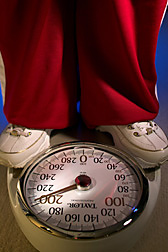This page has been archived and is being provided for reference purposes only. The page is no longer being updated, and therefore, links on the page may be invalid.
New Findings About Dairy Consumption and Body Composition
By Alfredo FloresApril 10, 2007
New findings support emerging research that increased intake of calcium and low-fat dairy products may lead to lower abdominal fat tissue—or adiposity—at least in young adult white males, according to research funded by the Agricultural Research Service (ARS) and cooperators.
Theresa Nicklas, a professor of pediatrics at the Baylor College of Medicine (BCM) in Houston, Texas, has worked with collaborators at the Tulane School of Public Health and Tropical Medicine in New Orleans, La., on this study. The research was published in a recent issue of the Journal of the American College of Nutrition.
Nicklas works at the Children's Nutrition Research Center (CNRC) at Baylor College of Medicine (BCM) in Houston. CNRC is operated by BCM on behalf of ARS and in cooperation with Texas Children's Hospital.
Obesity is one of the most prevalent public health problems in the United States, with nearly two-thirds of the adult population—roughly 97 million Americans over the age of 20—considered overweight or obese. This study provided an opportunity for researchers to follow a well-defined biracial (whites and blacks) population representative of the total community to further investigate associations between calcium intake, dairy product consumption and overweight.
Participants included 1,306 young adults ranging from 19 to 38 years old from Bogalusa, La., and surrounding areas. Of these, 31 percent of black males were considered overweight, compared to 30 percent of white males, while 48 percent of black females were overweight, compared to 29 percent of white females.
Two measures were used to determine who was obese. The first was the body mass index, a measure that correlates height with body fat. The second was waist-to-hip ratio (WHR), which shows how fat is distributed around the torso.
A 0.7 WHR for women and 0.9 for men have been shown to correlate strongly with good general health. Women within the 0.7 WHR range are less susceptible to major diseases such as diabetes, cardiovascular disorders and ovarian cancers. Men with WHRs around 0.9 have also been shown to be healthier, with less prostate or testicular cancer.
No significant association was found between dairy product consumption, calcium intake and overweight, as defined by body mass index or waist circumference. But white males in the study who ate more calcium and low-fat dairy products benefitted by having a reduction in their WHR.
ARS is the U.S. Department of Agriculture's chief scientific research agency.

